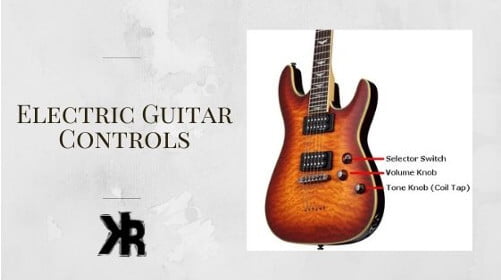Table of Contents
Have you just begun playing the electric guitar? Or do you simply want more flexibility from your gear? Then it’s great to know what the controls do.
Do you simply turn the tone and volume knobs up to max and leave them there? If so, you are missing out on some amazing sound shaping that is right under your fingers.
There are a lot of different guitars on the market. Some with unique controls and others with common layouts among most models.
In this Killer Rig article, we are going to explore different models. Plus, learn about how the electric guitar controls can help you get some great tones.
Most Common Electric Guitar Controls
Now that you know the main controls used on an electric guitar, let’s explore them in greater detail.
Tone Control
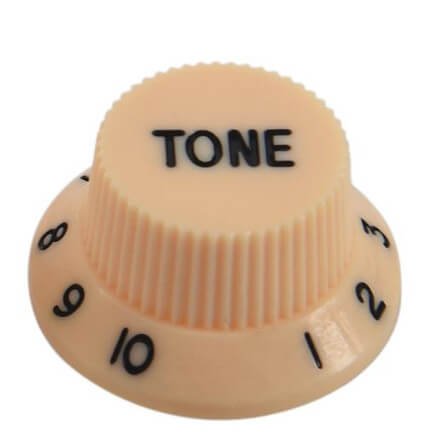
Your guitar’s tone control is a knob that modifies the treble or highs in your sound. Turning to the right (max) will give you the brightest sound. As you turn it to the left, it will get darker.
The tone control knob might be very helpful when you need to alter your sound. And without having to adjust the settings on your amp.
For instance, if you are using an amp that is extremely harsh and bright. The treble content can be reduced with a twist of the tone control.
The tone control is also an excellent way to go from a bright clean part in a song to a darker high-gain sound.
Most guitarists will use this control at its maximum setting. Normally because amplifiers do a great job at tone shaping. But there are some instances where you may need to quickly find a better balance in your sound.
Volume Control
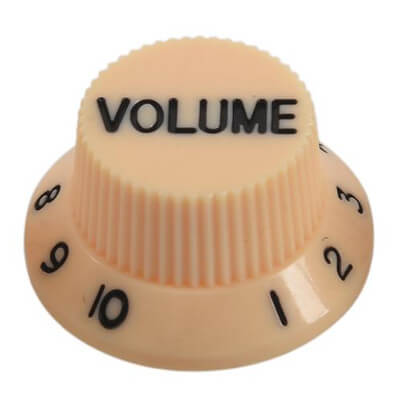
The volume knob does more than just control loudness. Let’s say you’re playing a song that starts with a clean verse and then explodes into a distorted chorus.
Start with the volume knob at 5 for a clean tone during the verse. When the chorus hits, roll the volume up to 10 for that full-on distortion, all without touching your amp or pedals.
It’s also possible to use your volume control for solo boosts. Simply set your volume knob in the middle, then configure your amplifier the way you like. And whenever you need a solo boost, you can turn up the control.
Pickup Selector Switch

The selector switch is used to select which pickups are active at any given time. Most electric guitars will have two or three pickups.
The position of the switch will determine which pickups are active. For example, if you are using the neck pickup and want to add in the bridge for a brighter sound. You would need to switch the selector.
This is generally a three-way switch. It has positions for the neck, middle, and bridge pickups. Yet, some guitars will have a five-position switch. It gives you access to all the different pickup combinations.
Because each pickup position produces a different tone, this switch is very powerful. Most guitar players use the bridge position for rhythm tones. This is because it’s brighter and clearer, but still produces a good amount of low-end.
The bridge pickup on the other hand is used for leads because it’s a much fuller-sounding tone.
Being able to switch on the fly in the middle of a song is a technique that just can’t be beaten. Especially when it comes to versatility!
Other Electric Guitar Controls
While the three main controls are the most important, there are a few others. They are also great features that you may find on your electric guitar. They are a bit more advanced but are very useful.
- Coil Tap
- Phase Switch
- Piezo Switch
- Kill Switch
Coil Tap Switch
One common feature is a coil-tap switch. This is generally found on guitars with humbucking pickups. It allows you to split the coils in the pickup, giving you a single-coil sound.
This can be a great way to go from a very full and thick sound to a thinner, twangy tone. This function is normally controlled by a push-pull potentiometer. Commonly found in the tone knob position.
Pulling the knob up engages the coil tap which turns off one side of the humbucker. It now produces the single-coil tone. Pushing it back down returns the humbucker to its thick, full, and hum-free sound.
Phase Switch
The phase switch is found on guitars with at minimum two pickups. It reverses the phase of one of the pickups.
This can be used on both humbucker and single-coil pickups. It’s preferred on humbuckers, yet, as the sound becomes thinner when the pickups are out of phase.
This effect cancels out bass frequencies. The result is a more twangy, thin tone that can be great for versatility. Especially if you have a dark-sounding guitar. It’s not so good on a Stratocaster and some single-coil setups, as the sound becomes very thin and harsh.
This function can be found using regular short-handled toggle switches. But is sometimes built into the pickup selector switch configuration on some guitars.
Piezo Switch
This switch is found on electric guitars that have a built-in piezo pickup. These are generally located under the bridge and can be used to provide an acoustic-like tone.
The piezo switch will turn the pickup on and off. This can be a great way to go from a regular electric guitar tone to an acoustic sound. All without having to carry around two instruments.
The PRS custom 24 piezo is a perfect example of this. The switch engages the piezo and a blend knob then allows you to add the signal to the regular pickup tone. This can add some great sounds and is pretty versatile.
It’s not a very common switch as it is more of a rare feature on electric guitars, but they do exist!
Kill Switch
The kill switch is generally found on the body of the guitar near the strings. It’s used to mute the pickups so that you can create a chopped-up effect. This staccato effect can be great and has been used by players like Eddie Van Halen and Tom Morello.
The switch is normally in the form of a button that, when pressed, silences the guitar. Once you let it go, the signal returns so that you can time the effect well.
Some come in a latching toggle switch, which also works well as a mute when you want the guitar to remain in the off state.
Common Control Knob Layouts
We’ve explained all the different electric guitar controls. Now let’s take a look at some of the most common layouts.
Fender Stratocaster
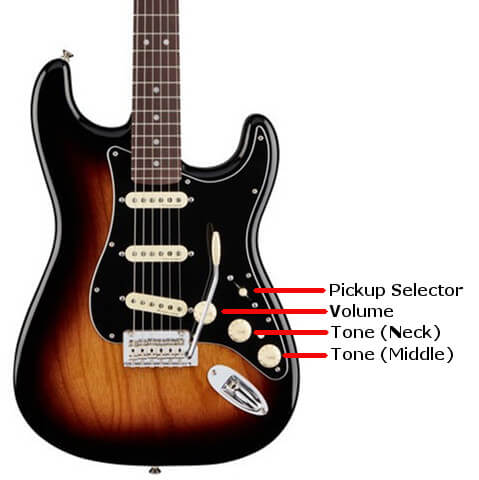
The Stratocaster is one of the most popular guitars in the world. It has been used by everyone from Jimi Hendrix to Stevie Ray Vaughan.
It features:
- Three Single Coil Pickups.
- 5-way selector switch.
- Two Tone knob controls.
- One Volume knob.
The Stratocaster design provides a tone control knob for the neck and middle pickups. Yet, not the bridge. As a result, the bridge position is very bright and cannot be adjusted.
This is a common design for Stratocaster guitar types. The one volume control knob is global and sets the output of the entire guitar.
Some players modify the design to add a tone control knob for the bridge pickup. This can reduce the brightness, which is desirable for some guitarists.
Then, when using the 5-way switch, you can change between many pickup configurations as seen in the table below:
| Pickup Selector Switch Position | Pickups In Use |
|---|---|
| Position 1 | Bridge Pickup |
| Position 2 | Bridge and Middle |
| Position 3 | Middle Pickup |
| Position 4 | Neck and Middle |
| Position 5 | Neck Pickup |
Related: Do electric guitars all sound the same?
Fender Telecaster
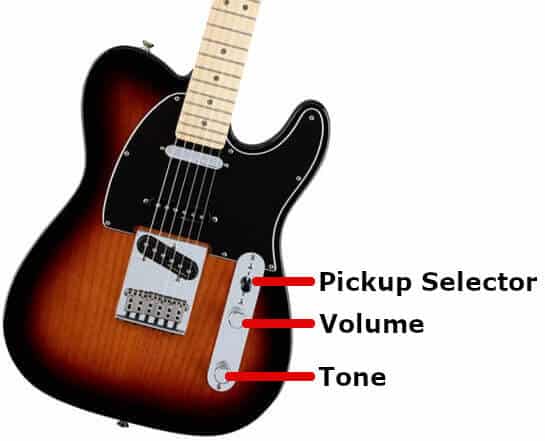
The Telecaster is a pretty basic guitar. It features only two single-coil pickups and a simple control layout. It, too, is a very popular guitar because of the great sound and feel it offers.
The control knobs on this guitar include:
- Two Single Coil Pickups.
- 3-way selector switch.
- One Tone knob.
- One Volume knob.
The tone and volume knobs on this guitar control both pickups at the same time. Depending on the setting of the 3-way switch. You can choose between each pickup by itself or in use together for a bigger sound.
Gibson Les Paul
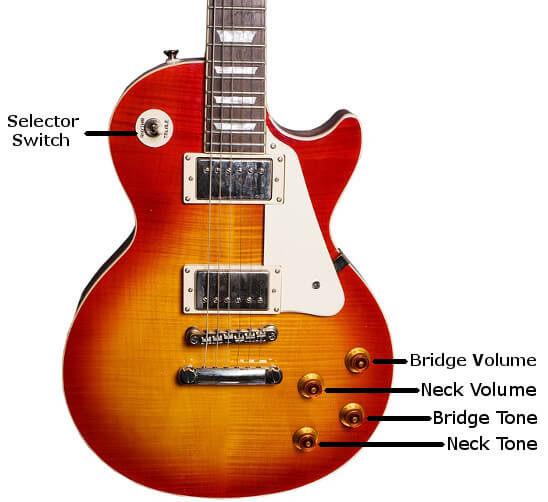
The Gibson Les Paul is another iconic electric guitar! It has been used by many players like Slash and Tony Iommi.
It features:
- Two Humbucker Pickups.
- 3 way pickup selector switch.
- Two Volume control knobs.
- Two Tone knobs.
This design provides independent volume and tone control knobs for each pickup. This allows for a great deal of versatility in terms of tone.
The 3-way selector switch is standard on all Gibson electric guitars. It allows you to choose between the neck, bridge, or both pickups.
With this kind of control, you can set the tone and volume of each pickup independently of the other. This is great if you want one sound to be louder than the other. Some players use this control for solo boosts by having a louder neck pickup signal.
Ibanez, PRS, and Other Designs
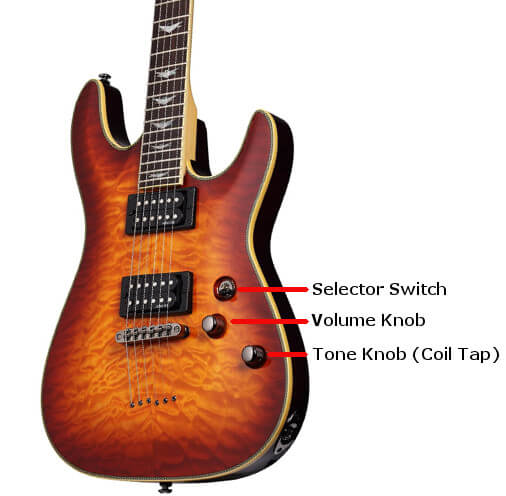
There are many other electric guitar designs out there. Some don’t necessarily fit into one of these categories. Ibanez and PRS are two examples of companies that make great guitars. Each with their own control designs.
With these designs, you will find:
- Two Humbucker Pickups.
- One Tone Control Knob.
- One Volume Knob.
- 3-way Selector Switch.
These designs are far more simple. You can still switch between the two pickups, but the tone control knob adjusts both of them. The volume knob is much the same and controls the output over the entire guitar.
More players prefer these controls because they are very straightforward. They don’t clutter up the guitar body. Many people like the Les Paul guitar, but get confused with the controls.
This control layout is typically where you will find push-pull switches. Both for coil tapping and phase inverting. It depends on the brand, of course, but it’s the simple layouts that can offer the biggest gains.
Unique Control Configurations
Some guitars are unique when it comes to the control scheme. The Fender Jaguar is one such guitar that features a series of slide switches. The guitar itself is similar to the Stratocaster but only has 2 pickups.
Then it gets interesting as there are slide switches for:
- Lead and Rhythm
- Rhythm Tone
- Rhythm Volume
- Mid-Tone Cut
- Lead Pickup On/Off
- Rhythm Pickup On/Off
It’s a very busy guitar! All these switches determine which pickups are active at any given time. Plus some tone shaping. Once you become familiar with the controls, it’s a pretty cool guitar!
When To Use Each Control
The best way to understand how each control works is to experiment with them. You can use the volume control to clean up your sound or make it dirtier. The tone knobs can be used to shape your sound and make it brighter or darker.
Some people like to use the 5-way switch on their Stratocaster to get different tones. For example, the bridge and middle position are great for blues. The neck position is great for jazz.
When it comes to humbuckers, most people prefer to use the bridge pickup for rhythm. This means then that the neck is for leads. Then use the controls to fine-tune the sounds.
It comes down to experimentation to see what sounds good to you. There are no right or wrong answers when it comes to electric guitar tones. It’s all about what you like!
Troubleshooting Common Electric Guitar Control Issues
Scratchy or Noisy Knobs
Symptoms: You hear a scratchy noise when turning the volume or tone knobs.
Solution: This usually indicates dirt or oxidation on the potentiometers. A quick spray of contact cleaner into the pots often solves the issue.
Inconsistent Volume Levels
Symptoms: The volume jumps or drops suddenly when you adjust the volume knob.
Solution: This could be a sign of a worn-out potentiometer. Consider replacing the volume pot for a more consistent response.
Tone Control Has No Effect
Symptoms: Turning the tone knob doesn’t change the sound.
Solution: The tone capacitor might be faulty or disconnected. Check the wiring and consider replacing the capacitor if needed.
Pickup Selector Issues
Symptoms: Sound cuts out or changes unexpectedly when using the pickup selector switch.
Solution: The switch might be dirty or worn out. Try cleaning it with contact cleaner. If the issue persists, consider replacing the switch.
Hum or Buzz When Not Touching Strings
Symptoms: You hear a hum or buzz that goes away when you touch the strings.
Solution: This is often a grounding issue. Check the guitar’s ground connection and make sure it’s secure.
Coil Tap Not Working
Symptoms: The coil tap switch doesn’t seem to change the sound.
Solution: Check the wiring to make sure it’s properly connected. If everything looks good, the switch itself might be faulty and may need replacement.
Controls Feel Loose
Symptoms: Knobs or switches feel loose or wobbly.
Solution: Tighten the nuts holding the pots or switches in place. If they continue to feel loose, you may need to replace the hardware.
Conclusion
Electric guitar controls can be confusing at first. But they are quite simple once you understand what each one does. It’s best to spend some time getting familiar with the controls and then practice using them.
After some time, you will memorize them and incorporate new sounds into your music. Don’t be afraid to try different things and see what works best for you.
FAQs
Why are there 2 tone knobs on a Stratocaster?
There are 2 tone knobs on a Stratocaster to allow you to adjust the neck and middle pickup sound. When turned to max, the tone will be bright, as the treble frequencies are allowed to pass.
When turned down, the treble frequencies are removed or shelved. This provides a warmer tone and reduces the brightness.
Can you replace the knobs on an electric guitar?
Yes, all knobs on an electric guitar can be changed. Manufacturers put their knob own designs on, but you can change them or replace them if they break.
You just need to make sure the knob will fit on the potentiometer shaft, as there are a few different styles.

